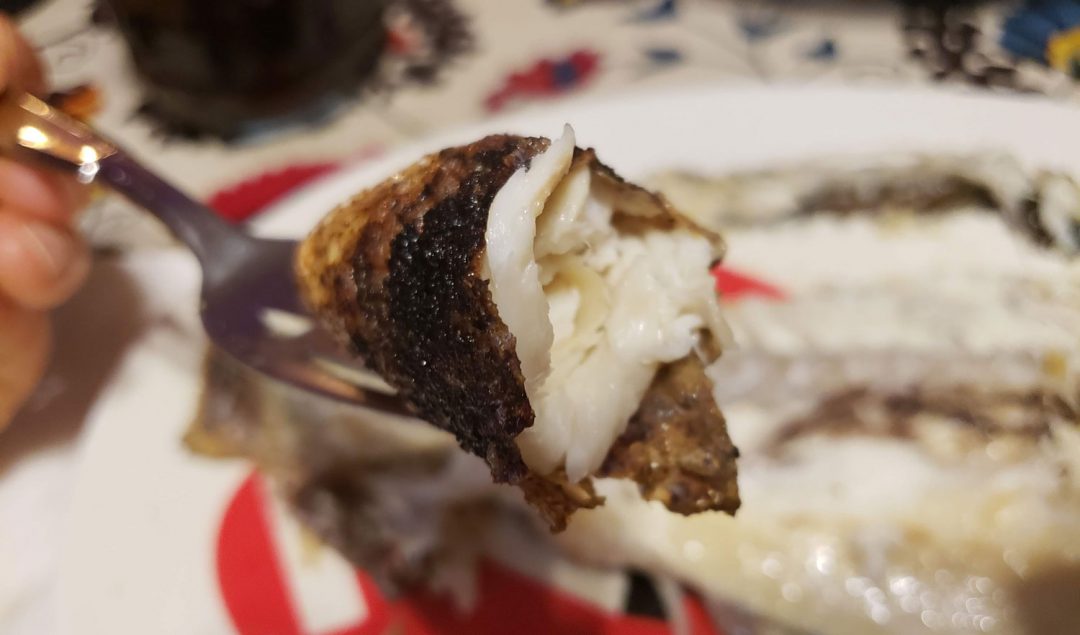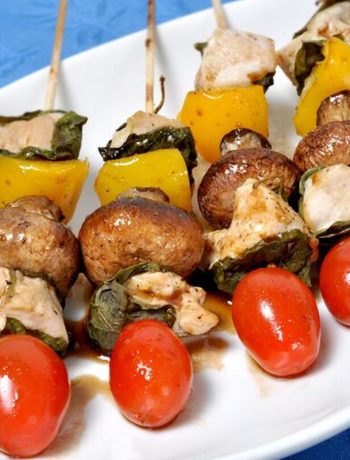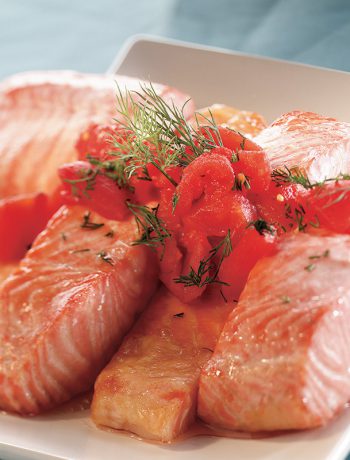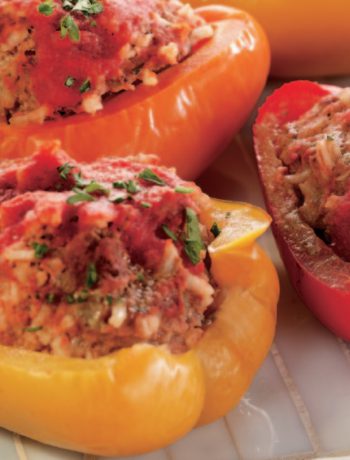The Superheated Steam Countertop Oven has really changed my attitude about preparing meals. Being able to put together a whole sheet-pan dinner with the care-free, whimsy normally reserved for microwaving is liberating. It is more sophisticated than popular countertop grill presses. It cooks at higher temperatures than most air fryers. And, it is roomier and more practical than any toaster oven I have ever had.
Eating well and making mindful choices should be quick and easy. That’s one of the reasons that I have chosen to focus more on fish and seafood. Weeknight dinners need to move quickly, for me. I get home late. The time is takes to prepare dinner, and the time it takes to clean up afterwards is time not spent with my family. Most fish cooks in less time than it takes to prepare it, so it is an obvious choice.
First, we took a deep, deep dive into Chilean Seabass Filets. Then we applied most of the same technique to Halibut Steaks, while appreciating the differences between the two. Now, we have earned the right to plunge fearlessly into the deep end of the grown-up menu. Whole fish. Specifically, branzino.
Branzino is the Italian name for Mediterranean Sea Bass. In French, it is called, loup de mer (rhymes with “Pooh the bear”). On the Greek menu, it is lavraki (sounds like, “Love, Rocky.”). Since it was discovered to take well to fish-farming, its popularity has exploded in the United States. Truly, it is almost difficult to find branzino in Italy, and even more difficult to find a New York City restaurant that doesn’t have branzino on the menu.
Its popularity is easy to understand. Branzino is a hearty white fish with a delicate flavor, and yet a satisfying richness that you cannot get from flounder. It also has a modest amount of fish oil, so it is very forgiving of aggressive cooking methods. You can get amazing results on the grill, in the oven, over a fire, and flash-fried in a heavy skillet. Often overlooked is the benefit of a relatively simply skeletal structure. There really aren’t that many bones, and they are easily dealt-with. You need to be careful, certainly. But it’s not that bad.
Preparing the Branzino
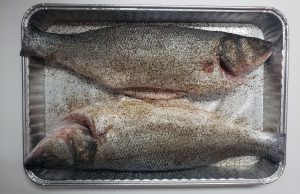
I admit that I have the fishmonger at the supermarket do most of the heavy lifting here. The fish is “cleaned”, which includes removing the scales, the gills and the entrails. However, when I get the fish home, I like to double-check a few things.
First, I unpack the fish and dry it with a paper towel. You cannot get crispy skin if you put it in the oven wet. While you’re doing this, wipe the paper towel from tail-to-head a couple of times. If there are any scales left on the fish, remove them with your fingers. It is pretty easy. The scales are bigger than you think they are, and there are a lot less of them than you would think. It would take you longer to pick up a scattered deck of cards than it would to remove the scales from this fish. Most people don’t realize this, but it’s really just the fins and scales that smell fishy. If you clean your fish properly, you will notice the difference. I’m not saying that I have forgotten about my Sharp Plasmacluster Air Purifier – but giving it less work to do is never a bad thing.
If the fishmonger forgot to de-scale it altogether, or there are more scales than you are willing to deal with, you will have to take care of it yourself. Fill the kitchen sink with water and hold the fish to the bottom of the sink and drag a knife from tail-to-head. Doing this underwater makes sure that little scales will not fly all over your kitchen. When you are done, the scales will wash away down the drain.
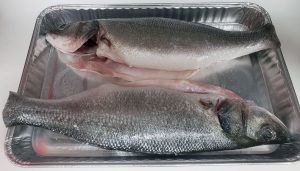 Once you have dried the fish, it is much easier to handle. Take your poultry shears or strong kitchen scissors and remove all of the fins and trim the tail back as much as possible. The dorsal fin that runs along is spine is the one you need to pay attention to. It is tough, spikey and very, very sharp. Carefully snip each barb at the base, even into the skin a little, and clip it all away and discard. Then remove the entire tail fin. In order to cut away the fan of the tail fin completely, you will need to cut into the base ever so slightly. The remaining 6 fins are quickly and easily snipped away. The first two are behind the gills – they are the ones you are thinking of. The other four are much smaller, thinner, and white so people tend not to notice them. Both sets are along the belly-side; two near the head, and two just under the tail. One last pass with a paper towel to clear any clippings would be a good idea. When you are done, they should look like the photo above.
Once you have dried the fish, it is much easier to handle. Take your poultry shears or strong kitchen scissors and remove all of the fins and trim the tail back as much as possible. The dorsal fin that runs along is spine is the one you need to pay attention to. It is tough, spikey and very, very sharp. Carefully snip each barb at the base, even into the skin a little, and clip it all away and discard. Then remove the entire tail fin. In order to cut away the fan of the tail fin completely, you will need to cut into the base ever so slightly. The remaining 6 fins are quickly and easily snipped away. The first two are behind the gills – they are the ones you are thinking of. The other four are much smaller, thinner, and white so people tend not to notice them. Both sets are along the belly-side; two near the head, and two just under the tail. One last pass with a paper towel to clear any clippings would be a good idea. When you are done, they should look like the photo above.
Spray the pan, or foil, with nonstick spray and arrange the fish for seasoning. This is a quarter-size sheet pan liner. It fits perfectly on the broiling pan or crisper try – with 3.5” left to spare. I used that extra space to cut 2 lemons in half and roasted them along with the fish.
Seasoning is simple. Fish is expensive. If you are spending the money on fish, you should taste it. And whatever you do to one side – you need to do to the other side. It is alarming how many people choose to season only ONE side of their food. My personal choice is almost always: sea salt, black pepper, spritz of olive oil. In that order. We’ve discussed this before. If you put the oil on first, you are just blocking the salt from doing its job and missing out on some of the black pepper flavor as well. In this case I also used a little grated lemon zest mashed in a teaspoon of sugar.
That one gets me looks. Hear me out.
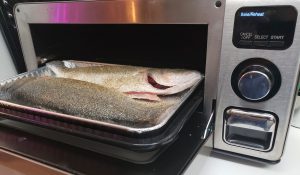
The lemon oil in the zest is powerful and lemony, sure. But much of the oil is still locked in the zesty bits. If you don’t happen to bite down on one of those fleshy little bits to release the oil – you won’t taste it. Mashing the sugar into the lemon zest, grinds more lemon oil from the zest and passes it to the sugar. When the sugar melts, it flavors the food more evenly. Also, lemon zest really is a little more bitter than most people are willing to admit – even if you don’t catch any of the pith. The sugar balances the bitterness and adds a well-rounded, umami to the entire dish. At the table, each bite will engage your taste buds with salty, sweet, sour and bitter. Season the outside liberally.
Let’s talk stuffing. Stuffing is nonsense.
French chefs and cooking shows love nothing more than to stuff the cavity of a fish with lemon slices, garlic cloves, and $5 worth of herbs. Sometimes they even tie the stuffing into the fish with butcher’s twine in the hopes of locking in the flavor that will magically permeate throughout the meat. This is all useless.
The body cavity of any animal is designed to be waterproof insulation. The lining of the cavity’s sole purpose is to keep the internal organs isolated and away from the flesh for the entire life of the animal. What do you think a bay leaf is going to do in there? You may as well put all those lemons and herbs in a zip lock sandwich bag.
Think about it. After hours in the oven, does any slice of Thanksgiving turkey taste anything like the stuffing? Of course not. Quite the contrary, you have the case of “stuffing vs. dressing.” The argument is that the stuffing tastes better when it is cooked inside the bird. No one ever argues that the bird tastes better because of the stuffing was cooked inside of it. The juices come from the meat and bones as they cook, and those juices get absorbed by the bread in the stuffing – this process doesn’t work in the opposite direction.
So, “no.” I do not stuff the cavity of the fish. I don’t even season it. No one eats it – so why waste your time?
I digress.
Cooking
Set the oven to Bake/Reheat, 485°F and set the timer for 40 minutes (for now). Cook until your desired doneness and cancel out the rest of the time when you are done.
As always, this is a matter of personal preference. Some people would be happy at 12 minutes, with the fish still being very rare on the inside. While that is certainly delicious, I find it tedious to debone whole fish when it is rare. I prefer it cooked through to the point where you can cleanly lift the center bones right off the meat. I also like the skin to be a little crispy so I cook it for a little longer. I like to wait until I see that the olive oil bubbling on the surface of the skin as if it were in a deep fryer, then I will open the oven door for the first time. I may also cancel out the time and switch to broil if the skin still isn’t crispy enough for me. This took about 26 minutes, but the time depends on how cold the fish was when you put it in the oven in the first place.
Serving
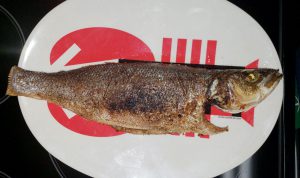
When it is time to plate, choose a dish that is much, much larger than the fish. You will need all of that room to maneuver while you clean the fish. Eating fish on-the-bone involves mush more “pushing” than “lifting” so you need some place to go. SeriousEats has a great tutorial about how to serve yourself.
I like to try and get crispy texture of the skin with every bite.
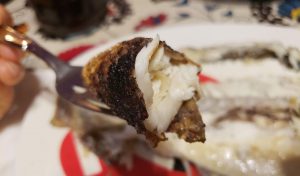
Oh. And you deserve wine now. This is a grown-up meal, you should have a grown-up drink. Branzino can hold up to a Sauvignon Blanc, but avoid the fruity, sour-plum notes and stick with the minerality of a firm Sancerre. Pinot Grigio is a safer bet. Chardonnay can get too sweet for me, but something bright from Napa Valley will work well. Branzino is fairly oily, so it could stand up to a red if you do not drink whites… but I would stay in the Beaujolais section, and try to stick to Nouveau.
Cleanup doesn’t get easier. Throw away the aluminum pan. Dishes in the dishwasher. Wipe the Superheated Steam Countertop Oven with a damp paper towel if you need to, but other than that, you’re done! Good thing, too. This wine is going to my head!

